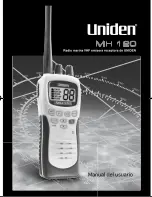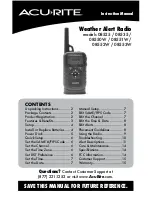
SD-225 User’s Guide
©
2006, Midland Radio Corporation
13
The normal operating channel should be selected using the
internal DIP switch, SW401. The radio channel may also be
selected by serial commands, but the radio will always power up
on the channel selected by the DIP switch.
1.
Remove the four screws securing the top cover and remove the top cover.
2.
Set the DIP switch for binary channel selection according to the chart
above, i.e. channel 1 is all switches off, channel 16 is all switches on.
3.
Replace the top cover and secure with the four screws.
Status LED
The LED on the top cover indicates the status of the data radio.
If a speaker has been connected to pin 9 of the radio interface
connector, audible tones can be heard indicating certain
conditions.
Radio Mode
Radio Status
LED Indication
Beep Indication
Power-on Green
Æ
orange
Æ
red
Busy channel
Steady orange
Busy channel w/correct
CTCSS/DCS
Steady green
Normal
Operation
Transmit Steady
red
Busy channel lockout
Continuous green flash
when PTT activated
Continuous beep
Time out timer expired
Continuous green flash
while transmitting
5 sec before time out timer expires
One green flash
Single beep
Subaudible disabled for data input
Two green flashes then
red when PTT active
EEPROM error
One orange flash
Out of lock
Four yellow flashes
Communication error with modem
MCU
Continuous green flash
Warning
Transmit hang time
Continued steady red
when PTT released
Program read
Continuous red flash
Program
Program write
Continuous green flash
Initial data load
Green
Æ
orange
Æ
red
Open level set
Three green flashes
Close level set
Two green flashes
Squelch set
Squelch level save
One green flash


































